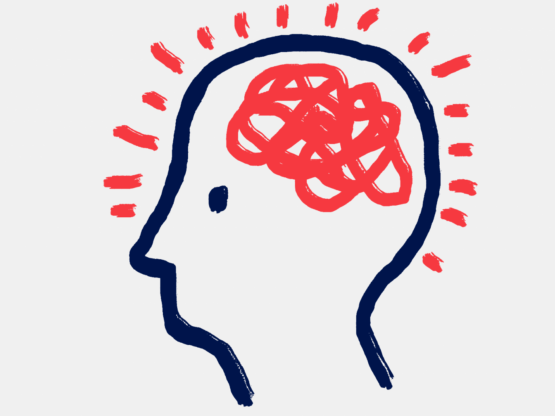REFLECTIONS ON LECTURES/SOURCE MATERIAL
Defining Methods of Thinking, Curiosity and Insight (debate around the constructs of thinking and generating ideas).
PROCESS MODELS (Historic)
1922/Bauhaus: Widely acknowledged as one of the first schools to apply process connection between design and industry meeting the demands of emerging technologies of the day or design for mass production. It was Johannes Itten who introduced gymnastic and breathing exercises into his classes to create 'direction and flow'. (Bauhaus by Magdalena Droste/Taschen. P25: Johannes Itten, P35: Structure of the School Curriculum).
— Interesting that Gropius' foundation course structure is still more or less in use in art colleges today.
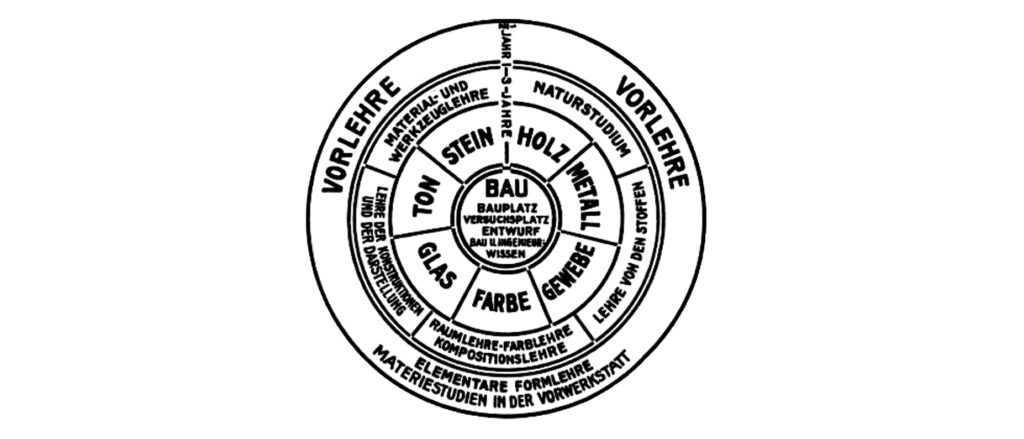
"Form ever follows function".
Louis Sullivan
—
"Creating a fit between knowledge and design within an organisation and designing with markets in mind can be a key driver for innovation".
Reinmoeller 2003
—
1963/Bruce Archer/Design Methods Movement: Introduced model of design process in an attempt to free up creativity by introducing a 'scientific' approach. This design 'science' was Inclusive of the creative process and external influences.
1990/Brian Lawson: Linear mapping for best design practice. Archer and Lawson's models the most adopted in the design industry.
— I find both of these process models too linear for what we do as the process itself is very rarely ever linear but rubber-bands on itself, somewhere between the last design stage, production and realisation. Sometimes, after a period of research you have to go right back to the concept stage. It's much more fluid.
The last 40 years: (and now I see from my notes…) Archer's and Lawson's process models criticised for their linear constructs. A new idea of loops and phases takes into account the wider activities of the design process; enabling time to evaluate and test ideas, and the designer to consider a number of concepts at one time.
— RE: Iteration Process: Should stay in house and after a period of evaluation you should only present 2 options max.
Today: Increase in design awareness and the levels of complexity have increased (Tech, Sustainability, Social Responsibility, Legislation…).
'Our world is evolving so quickly that there may never be an ideal methodology or process. What matters therefore is that a flexible infrastructure is in place with the foresight and intelligence to respond quickly and appropriately to creative change'.
Design Council/Desk Research Report (2007)
—
The Design Council's Double Diamond (2007): 4 Phases: Discover, Define, Develop and Deliver. A linear model with in-built flexibility (loops and phases).
On Discovery: 'This early phase has been referred to as the fuzzy front end (FFE) and it is critical to defining the nature of the problem that is being addressed through design (Rhea 2003). It is also the one which makes best use of the designer’s knowledge and skills.
— In my own experience this is the model we currently employ in industry, whatever way it is drawn or represented by the agency.
—
MANAGING THE DESIGN PROCESS
Gorb and Dumas (1987): Published a paper discussing the concept of Silent Design acknowledging the significant amount of design activity that goes on within an organisation which is not actively acknowledged as being design.
1990's/Stefano Marzano/Philips Design: The High Design Process Holistic Approach. 5 key phases: Initiation, Analysis, Concept, Finalisation and Evaluation.
'…an effective design policy and process allows the knowledge captured… lessons learned to be re-integrated into the process and improve it'.
Design Council/Desk Research Report (2007)
—
CREATIVE THOUGHT PROCESSES
Edward de Bono's 6 Thinking Hats: Controlling the creative process with focused thinking. White = Information Gathering, Red = Feelings, Intuition and Emotion, Black = Caution, Criticism and Risk Assessment (Overuse can kill creative ideas and positive thinking), Yellow = Benefits, Feasibility, Optimism and Logic, Green = Creativity, New Ideas and Possibilities and Blue = Process Control.
— I found this whole process really inspiring and can see the benefits of a well managed meeting using this method. It can also be used in conjunction with the Double Diamond model for gaining insights at all stages of the process.
Daniel Kahnermann/Thinking Fast & Slow: System 1 = Automatic, quick with little or effect or voluntary control. System 2 = Attention to effortful activity that demands it including complex computations, agency, choice and concentration.
"The mind is like an umbrella — it functions best when it is open".
Walter Gropius
—
HOW THE MIND WORKS
The Divided Mind/Ian Gilchrist (RSA Animates)/Alfred Anwender.
— Need to go back to school on these. The left side of my brain partly understands but the right side says no. Science is not my strong point.
"Computer says no".
Little Britain
—
TAKE OUTS
— Process models work best when they are flexible enough to allow the creative process to thrive.
— Structuring the process using the Double Diamond method with set phases allow for this flex.
— Include all aspects of the business in your process that are not considered to be 'design'.
— There are no models that can encompass everything that we do and as the world changes we have to change with it.
— A holistic approach to the design process = better management of the process.
— Setting specific questions in a step by step approach allows for creative and focused thought.
— The left side of the brain is pragmatic and the right side likes to play and make friends.
— I'll never look at an MRI scan in the same way — I've brained my damage…
—
Thinking too much and thinking too little: While I enjoyed reading this article I don't think it's either wrong or right — it's just the writers own perspective. Just not my experience of my emotional and social self. I think in terms of design we can have the deep internal monologues that connect us to questioning and problem solving. I think it's an internal conversation and external one that triggers at the same time. Your brain helping you unravel complex content and defining what to prioritise, posing questions, sparking ideas, opening the imagination. Your ears listening in. Your eyes and hands connected in the process touching pen, paper and tools. The mind leafing through references and memories of relevance, visualising the possibilities. Your eyes and hands delivering the material. Thinking too much about a problem usually happens when you're tired and you have to have a cut off point. You can also overthink a piece of work that from someone else's point of view answers the problem perfectly. Thinking too little from a design perspective doesn't work either. It's like Kahnemann's Systems 1 and 2. However the role of fast thinking becomes a synthesised version of System 2. You have to use System 1 in a 'Rational' way asking whether the task requires the deeper internal connection and time gained by System 2, or whether it needs to a quick response and how do you get from A to B.
On Exercising the Mind: I found this article more relatable. It's about utilising the power of the mind to lead a more fulfilled emotional and social life and reach your goals in a constructive way. I like the image of the 'realm of the psyche' where you walk around fine tuning weaknesses and blind-spots. In design terms I believe that there should be an internal monologue (clarity) and external one (reinforcement) to find out your weaknesses and strength's — the areas you need to work on: How you present yourself to the world, greater understanding of how to solve a problem, how to deal with an issue when it arises. To become a better designer you have to practice your craft and better yourself in all aspects and areas and the mind is not disconnected from this process. One of the amazing things about our industry is that no two clients are really alike and the learning curve is always there for the discovery of new ideas and possibilities. Empathy is important for you to fully get behind a product, service or cause. You have to believe in what you do and what your benefactor does for the relationship to work. It's a true meeting of minds.
TAKE OUTS
— The mind and body have a symbiotic relationship when designing. It's a sensory experience.
— Mind = Control, Intelligence, Recall, Concentration, Understanding, Questioning, Problem Solving, Visualisation, Creativity, Imagination, Empathy.
— Ears and Brain = Listening.
— Eyes and Brain = Colour, Perception, Depth, Motion, Visualisation, Spacial Awareness.
— Hands and Brain = Body Language, Dexterity, Control, Craft, Sensory (Tactile/Touch).
— Cultivating ways to exercise the mind through clarification aids rational thought.
— It's important always to exercise control and not to let emotions come into play.
— Getting constructive feedback when combined with clarity leads to self improvement.
— Gaining clarity helps you to achieve work and personal goals.
—
COGNITIVE PSYCHOLOGY: Connecting the mind, research and everyday experience
(Book - Bruce E. Goldstein, 2015)
Cognitive Psychology: The scientific study of the mind.
The mind acts repetitions to achieve goals and to survive.
Perception: Seeing and hearing.
Attentiveness: External and Internal thought and understanding about what is happening at any given time.
Memory: Recall.
Categorisation: Mental Ordering.
Visualisation: Images from experience/memory.
Understanding: Language, Problem Solving, Decision Making.
Historical topics studied: Reaction time (Donders), Analytic Introspection (described experience in relation to stimulii/Wundt), Memory (time course of forgetting/Ebbinghaus), Attention (Principles of Psychology/James), Behaviour (Watson), Reward and Response (Operant Conditioning/Skinner), Mental Processes (Tolman), AI (Computer's as mind mimics/MacCarthy). Wundt debunked. Noam Chomsky attacked Skinner's theories regarding children.
'Mental responses cannot be measured but are inferred'.
Franciscus Donders
—
PERCEPTION
Interesting internal monologue in the brain between what the ears and eyes see, hear and how experience (recall) and thought processes the information.
Is perception what makes us individuals? Perception is the means by which we make judgements on the world around us.
"Person perception"refers to the different mental processes that we use to form impressions of other people (Kendra Cherry 2011/verywellmind.com. People see themselves differently from how they see others. This basic asymmetry has broad consequences. It leads people to judge themselves and their own behaviour differently from how they judge others and those others' behaviour (Emily Pronin 2008/science.sciencemag.org).
If we are aware that own own perceived judgements can cloud our view, how can AI possibly be employed analytically to single out 'individuals' of concern?
At the time of writing his book Goldstein refers to the difficulties of perception in machine learning. In a recent BBC Panorama programme (www.bbc.co.uk/iplayer/episode/m000wft2/panorama-are-you-scared-yet-human) the discussion is taken further, showing how machine learning is being perfected and used as a population controlling mechanism.

“When a man cannot choose, he ceases to be a man.”
Anthony Burgess, A Clockwork Orange
—
" If you want a vision of the future imagine a boot stamping on a human face – forever”.
George Orwell, 1984
—
TAKE OUTS
— Models play an essential role in by representing structures or processes (Goldstein).
— Process models illustrate how a process operates (Goldstein).
— Models make complicated systems easier to understand (Goldstein).
— Cognitive Psychology has opened up new approaches to thinking and ways to improve learning and behavioural patterns from greater understanding.
—
Workshop Challenge: Way's of Thinking/Mind Maps
REFLECTIONS ON ATTENTIVENESS
I found William James's study on attentiveness and the realisation that you only pay attention to stimuli you are interested in quite prescient in reading this book.
However, from my own perspective it's not through lack of interest, but sometimes a lack of understanding. According to Psychotactics.com almost all of us waste 90% of our time because we don't understand a simple concept called The Learning Pyramid (NTL Institute in Bethel, Maine. - 1960's). To counter this the author, Sean D'Souza offers the following suggestions: Create a mind map, talk to about the concept or write an article about it and so on.
"A simple concept is never just learned, It needs to be discussed, talked, written, felt…"
Sean D'Souza
—
THE IDEAS WALL
After reading William James's study I asked the question as to whether other students used processes or models to help them in the learning process. This is related to my own feeling that I struggle with read and condensing the material and I am looking for a better system to tackle this.
James mentioned mind mapping so I am going to explore this in more detail.
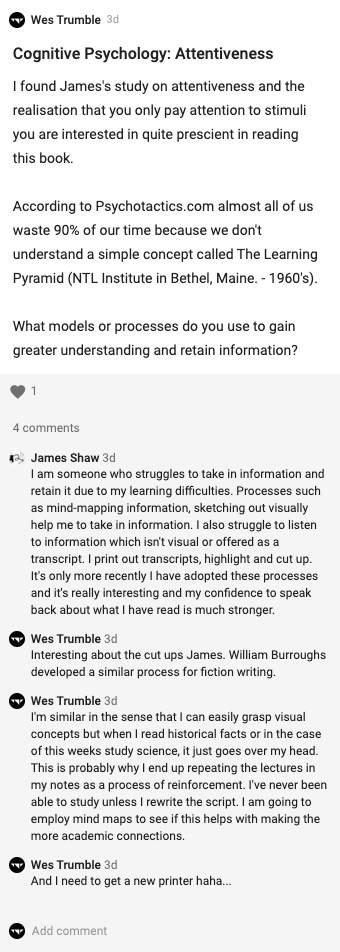
MIND MAPPING
The term "mind map", arose during a 1974 BBC TV series called Use Your Head hosted by Tony Buzan . Using his conception of a radial tree, Buzan argued that while "traditional" outlines force readers to scan left to right and top to bottom, readers actually tend to scan the entire page in a non-linear fashion. Using then-popular assumptions about the functions of cerebral hemispheres he claimed 'Mind Mapping' increased effectiveness over other forms of note making (Source: Wikipedia).
A mind map is a collection of ideas that have been put into the format of a visual diagram. Starting with a central idea or topic in the middle of the map, branches radiate from the center containing further themes and concepts to be explored – typically in the form of words, short phrases, and images (AYOA.com). So how can this improve your understanding and recall?
A study by Farrand, Hussain, and Hennessey (2002) found that mind mapping improved the long-term memory reporting that “mind maps provide an effective study technique when applied to written material” and that they are likely to “encourage a deeper level of processing” for better memory formation.
Glass and Holyoak (1986) found that by gathering and highlighting key branches within a boundary, you’re using technique known as ‘chunking’. Our short-term memory is on average only capable of storing seven items of information and chunking can help us use this storage space more effectively. (AYOA.com).
So how can we use mind mapping creatively to develop ideas? Mind maps really come into their own enabling you to generate new ideas in brainstorming because the spatial layout helps you gain a better overview, making new connections more visible. Adding images to a map can also aid in this process, acting as visual stimuli, enabling the brain to quickly make associations and recall information. (AYOA.com).
Brainstorming in groups should be viewed with caution though as research conducted points out:
'Sharing group ideas results in fewer ideas than people asked to think of ideas as individuals'.
Mullen et al., 1991
—
As a visual person, my learning and response to the visual stimulus of Goldstein's book was more resonant than the written communication. In conclusion, I will adopt new methods of thinking to increase my level of understanding from written studies starting by using mind maps as part of my process.
Sean D'Souza
—
BELOW: Process sketch showing Tony Buzan's personal Mind Map.
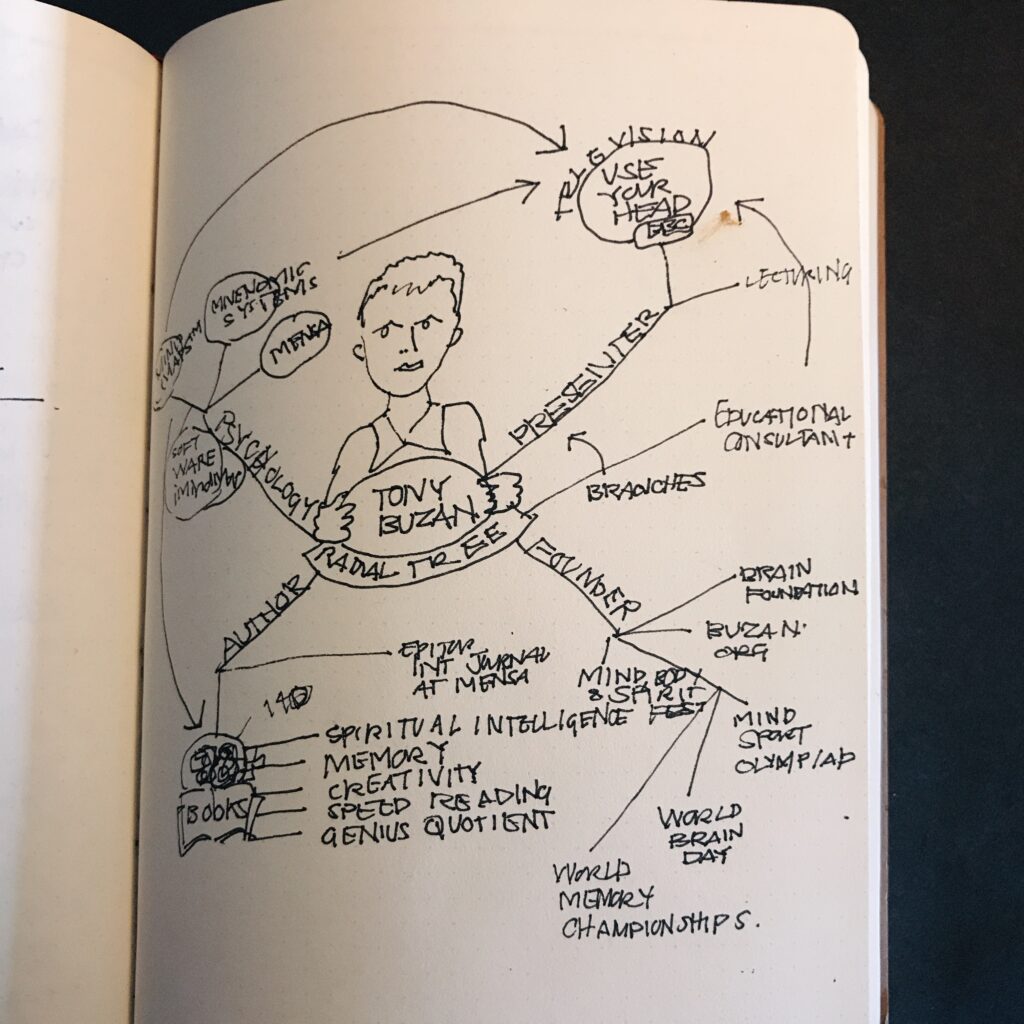
Workshop Challenge: Final Execution
TONY BUZAN/MIND MAP PROCESS DIAGRAM
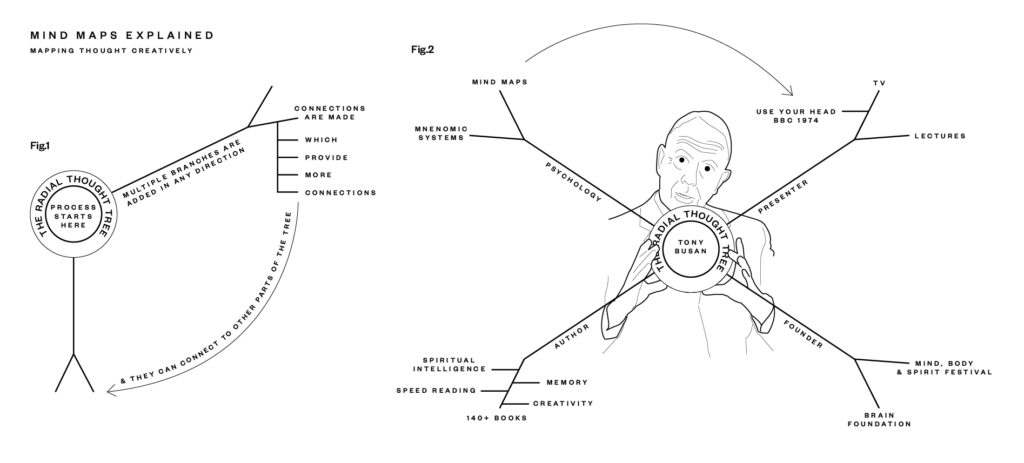
THE IDEAS WALL
Felt that I had taken a very literal approach but was reinforced by other students that this is a relevant direction and I was personally happy with it as I think it explains the process easily across two diagrams.
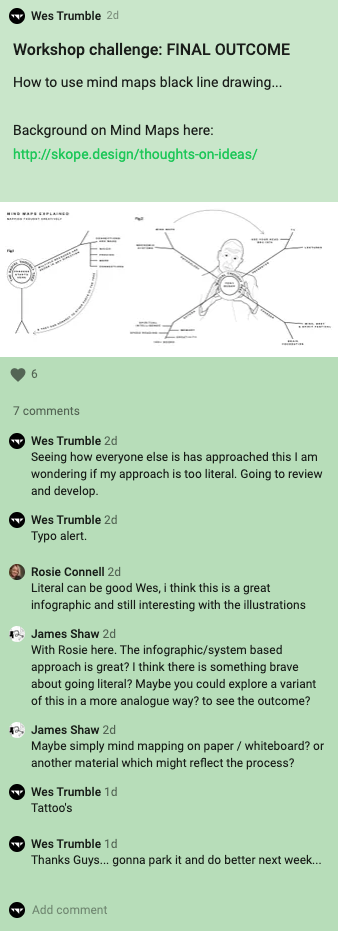
Workshop Challenge: Process Study
PAUL KLEE'S PEDAGOGICAL PROCESS
With his Pedagogical Sketchbook, the second volume in the Bauhausbücher series, Paul Klee (1879–1940) takes a theoretical approach to drawing using geometric shapes and lines. Klee’s text expresses key aspects of the Bauhaus’ pedagogy and guiding philosophies, oscillating between the seeming objectivity of the diagram, the rhetoric of science and mathematics, and an abstract, quasi-mystical intuition. (Source: www.lars-mueller-publishers.com/pedagogical-sketchbook).
In a step by step process, Klee first asked his student to take a 'line for a walk'. This process is interesting because while seemingly very structured using complex models and diagrams to explain the process, there was room left for self expression and creativity to take place. Beginning with the fundamentals, Klee modelled his teaching methods after the way children learn to read. “First letters, then symbols, then, finally, how to read and write. Klee would ask his students to repeat the same form in as many positions as possible. Such painstaking tasks would lay the groundwork for future works of art and design, and needed to be mastered before tone and colour entered the picture. (Source: www.gallerymckee.com/my-blog/154-lessons-from-paul-klee). This hold's parallels with the task that we have been set this week as colour wouldn't necessarily add clarity to our own explanation of a process. While I have exactly taken a 'line for a walk' in the free sense that Klee was referring to, I feel I have created a diagram with understanding, motion and play all intertwined.
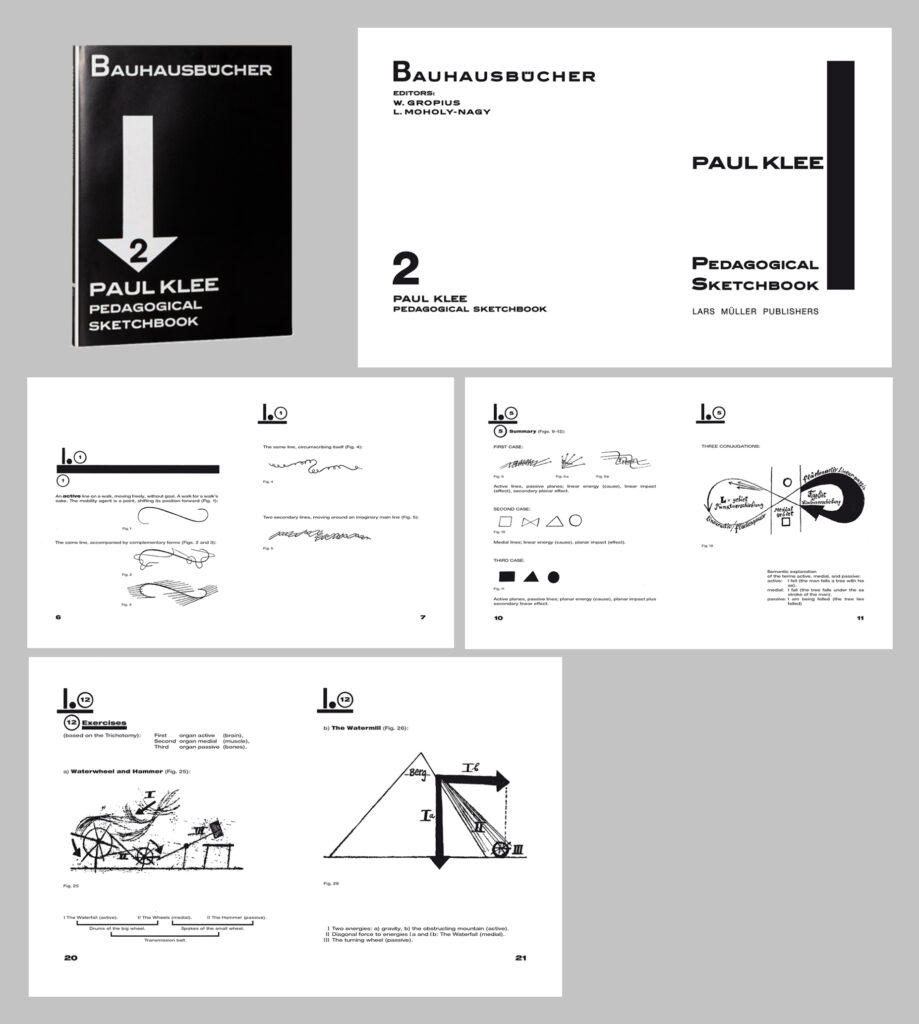
TAKE OUTS
— Mind Maps are a visual way of condensing information and especially useful in capturing factual strands.
— If I am to achieve my goal of becoming more individual/experimental in my work then I need to 'take a line for a walk'.

